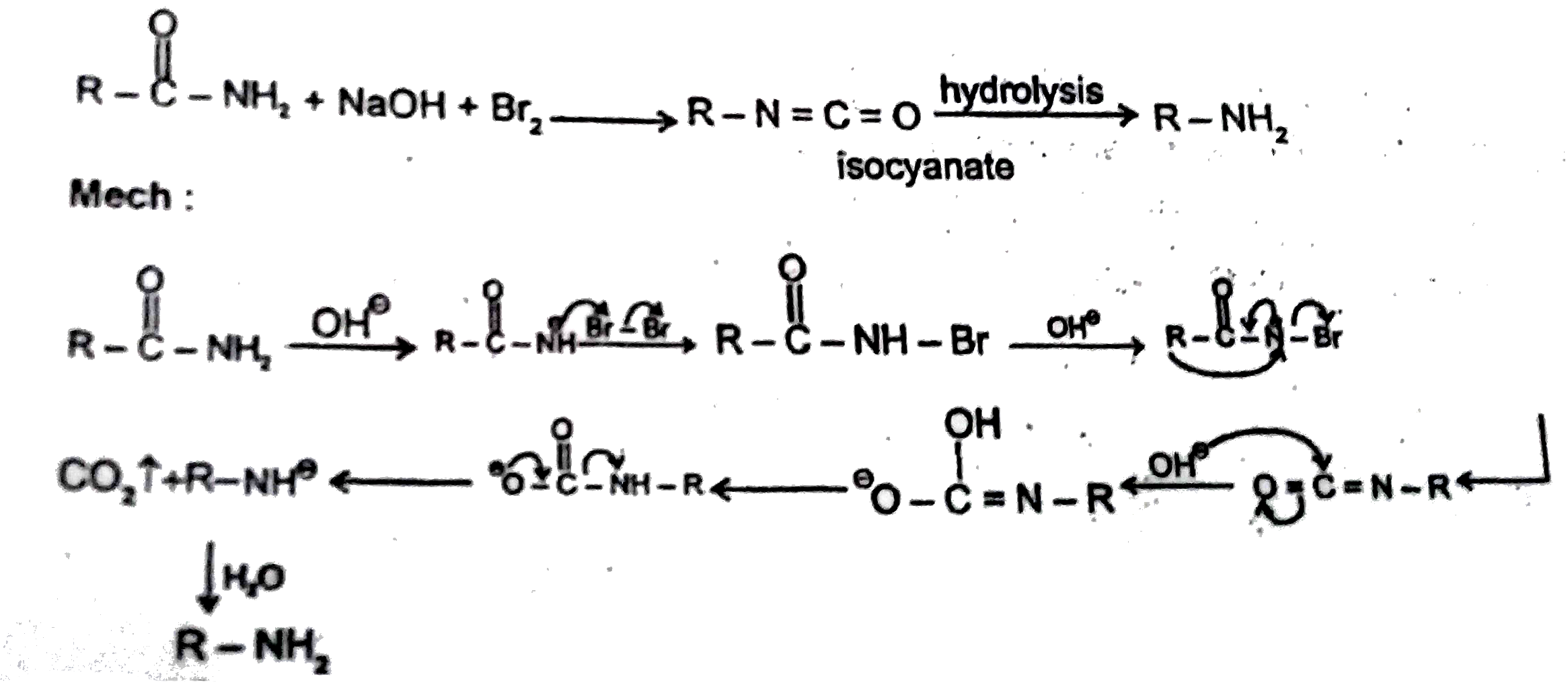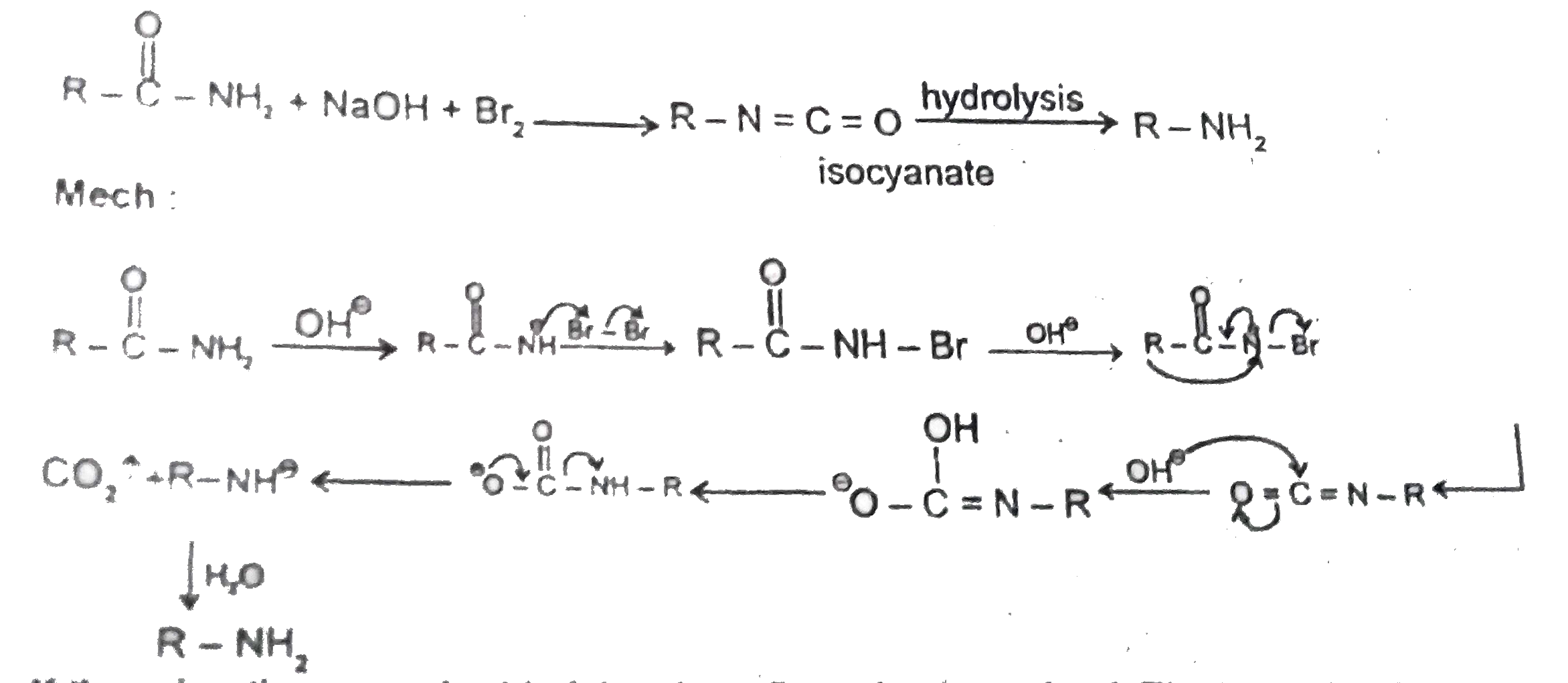Hofmann rearrangement during the conversion of an amide to amine is
intermolecular
intramolecular
both (a) and (b)
none of these.
The correct Answer is:B
Topper's Solved these Questions
- ORGANIC COMPOUNDS CONTAINING NITROGENBOOK - MTG GUIDECHAPTER - ORGANIC COMPOUNDS CONTAINING NITROGENEXERCISE - CHECK YOUR NEET
25 Videos
- ORGANIC COMPOUNDS CONTAINING NITROGENBOOK - MTG GUIDECHAPTER - ORGANIC COMPOUNDS CONTAINING NITROGENEXERCISE - AIPMT/NEET MCQs
21 Videos
- ORGANIC COMPOUNDS CONTAINING NITROGENBOOK - MTG GUIDECHAPTER - ORGANIC COMPOUNDS CONTAINING NITROGENEXERCISE - AIPMT/NEET MCQs
21 Videos
- HALOALKANES AND HALOARENES BOOK - MTG GUIDECHAPTER - HALOALKANES AND HALOARENES EXERCISE - AIMPT/NEET
10 Videos
- POLYMERSBOOK - MTG GUIDECHAPTER - POLYMERSEXERCISE - AIPMT/NEET
15 Videos
Similar Questions
Name the reagent for the conversion of an amide to amine containing the same number of carbon atoms.
View SolutionHofmann rearrangement
In the Hofmann rearrangement an unsubstitued amide is treated with sodium hydroxide and bromine to give a primary amine that has one carbon lesser than starting amide.
Gneral reaction:
If the migrating group is chiral then its configuration is retained. Electron releasing effects in the migrating group increase reactivity of Hofmann rearangement.
Arrange the following amides according to their relative reactivity when reacted with Br2 in excess of strong base:

View Solution
Knowledge Check
Hofmann rearrangement during the conversion of an amide to amme is
Aintenn olecularBintramolecularCboth (a) and (b)Dnone of these.A reaction that converts an amide into an amine is called
AHofmann bromamide reactionBGattermann Koch reactionCCarbylamine reactionDGabriel phthalimide reactionHofmann rearrangement
In the Hofmann rearrangement an unsubstituted amide is treated with sodium hydroxide and bromide to give a primary amine that has one carbon lesser than starting amide.

In the migrating group is chiral then is configuration is retained. Electron releasing effects in the migrating group increases reactivity of Hofmann rearrangement.
Arrange the following amides according to their relative when reacted with Br2 in excess of strong base :
 AIV>I>II>IIIBII>I>III>IVCII>IV>III>IDII>I>IV>III
AIV>I>II>IIIBII>I>III>IVCII>IV>III>IDII>I>IV>III
Hofmann rearrangement
In the Hoffmann rearrangement an unsubstituted amide is treated with sodium hydroxide and bromine to give a primary amine that has one carbon lesser than starting amide.
R−O∣∣C−NH2+NaOH+Br2→R−N=C=Oisocyanatehydrolysis−−−−−→R−NH2
Mech :

If the migrating group is chiral then its configuration is retained . Electron releasing effects in the migrating group increases reactivity of Hofmann rearrangement.
Arrange the following amides according to their relative reactivity when react with Br2 in excess of strong base

View SolutionHofmann rearrangement
In the Hofmann rearrangement an unsubstituted amide is treated with sodium hydroxide and bromide to give a primary amine that has one carbon lesser than starting amide.

In the migrating group is chiral then is configuration is retained. Electron releasing effects in the migrating group increases reactivity of Hofmann rearrangement.
Which of the following compounds (s) cannot give Hofmann rearrangement :
View SolutionHofmann rearrangement
In the Hoffmann rearrangement an unsubstituted amide is treated with sodium hydroxide and bromine to give a primary amine that has one carbon lesser than starting amide.
R−O∣∣C−NH2+NaOH+Br2→R−N=C=Oisocyanatehydrolysis−−−−−→R−NH2
Mech :

If the migrating group is chiral then its configuration is retained . Electron releasing effects in the migrating group increases reactivity of Hofmann rearrangement.
Which of the following compound cannot give Hofmann rearrangement :
View SolutionHofmann rearrangement
In the Hofmann rearrangement an unsubstitued amide is treated with sodium hydroxide and bromine to give a primary amine that has one carbon lesser than starting amide.
Gneral reaction:
If the migrating group is chiral then its configuration is retained. Electron releasing effects in the migrating group increase reactivity of Hofmann rearangement.
Arrange the following amides according to their relative reactivity when reacted with Br2 in excess of strong base:

View SolutionHofmann rearrangement
In the Hofmann rearrangement an unsubstitued amide is treated with sodium hydroxide and bromine to give a primary amine that has one carbon lesser than starting amide.
Gneral reaction:
If the migrating group is chiral then its configuration is retained. Electron releasing effects in the migrating group increase reactivity of Hofmann rearangement.
Which of the following compound(s) cannot give Hoffman rearrangement:
View Solution
